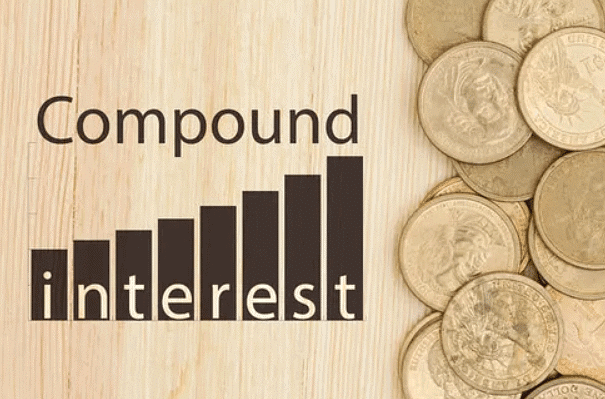Simple Interest and Compound Interest | Quantitative Techniques for CLAT PDF Download
| Table of contents |

|
| Simple Interest and Compound Interest |

|
| Simple Interest |

|
| Compound Interest |

|
| Solved Examples |

|
Simple Interest and Compound Interest
Principal is the amount on which interest is paid / earned.
If principal is denoted by P
The rate of interest is denoted by R
The time for which the principal is given on interest = T
Then
Simple Interest
Simple interest earned / paid is devoted by S.I.
Then (1) S.I. =
Amount (A) = P + SI (Amount is the sum of P and the SI earned)
Amount x 100 = Principal x (100 + RT)
Principal =
Compound Interest
Amount (A) =Or CI = A – P
Difference of CI and SI for a period of one year in zero
For 2 years the difference of CI and SI is
For 3 years the difference of CI and SI is
=

Solved Examples
Example 1: Ramesh deposited Rs. 29400 for 6 years at simple interest. After 6 years he received Rs. 4200 as interest. Find the annual rate of interest.
- P = Rs. 29400 T = 6 years SI = Rs. 4200
For finding out the rate of interest R
Example 2: I invested an amount of Rs. 17500 at the rate of 8% per annum. After how many years will I get Rs. 16800 as simple interest?
- P = Rs. 17500 R = 8% SI = Rs.16800
So T =
So time is 12 years
Example 3: Pritam invested Rs. 16840 at 6% for 5 years. What amount of SI, he will get after 5 years.
- P = 16840
R = 6%
T = 5 years
= RS. 5052
Example 4: At what rate percent per annum simple interest a sum of money doubles itself in 15 years.
- let the principal be Rs. 100
T = 15 years
SI = Rs.100
R = ?
Example 5: A sum of Rs. 3100 was lent partly at 5% and partly at 8% simple interest. The total interest received after 3 years was Rs. 600. Amount lent on 5% per annum was how much.
- let Rs. X be lent at 5%, then the remaining amount of Rs. (3100-x) was lent at 8%
So
Or 15x + 24 (3100 – x) = 60000
Or 9x = 74400 – 60000
 |
Download the notes
Simple Interest and Compound Interest
|
Download as PDF |
Short Cut Method
Let us suppose that whole amount was given at 5%
Interest =
But the interest earned in 600. It means some amount which earns Rs. 135 at 3% interest (8% - 5%) was given. This amount is
So 3100 – 1500 = Rs. 1600 was given an interest of 5%.
Example 6: The simple interest on a sum of money is 4/9 of the principal and the number of years is equal to the rate percent per annum. The rate per annum is what?
- Let the amount (Principal) be Rs. 1
SI = Rs. 4/9
Let rate be = x%
Then T = x years
As per the formula SI = PRT / 100
So rate per annum =
Example 7: In 4 years, the simple interest on a sum of money is 9/25 of the principal. Find out the annual rate of interest.
- Let the principal be Rs. 1
Interest =
T = 4 years
R =
Example 8: A sum of money at simple interest amounts to Rs. 1012 in 2½ years and to Rs. 1067.20 in 4 years. Find out the rate of interest, per year.
Solution: From the question it is clear that
Rs. 1067.20 – Rs. 1012.00 = Rs. 55.20 is the simple interest earned in a period of 1½ years. So now we can find the interest earned in 2½ year which will be
= 18.40 x 5 = 92.00
So the principal in the beginning was Rs. 1012-92 = Rs. 920
So now P = Rs. 920
T = 5/2 year
Simple Interest = Rs. 92
Compound Interest
To understand the method of calculating compound interest, let us consider an example.Example: I borrowed Rs. 40,000 from a bank. The bank charges interest at the rate of 10% per annum. At the end of the year I will have to pay Rs. i.e. Rs. 4000 as interest.
Thus total amount of Rs. 40000 + Rs. 4000 = Rs. 44000 will have to be paid back to the bank.
If due to some reason I am not able to pay, the bank will charge 10% interest for the next year on the principal of Rs. 44000. At the end of the 2nd year the interest will be Rs.
= Rs. 4400.
Thus total interest payable to the bank will be Rs. (4400 + 4000) = Rs. 8400. This interest is Rs. 400 more than the simple interest on 40000 for 2 years at 10%. This Rs. 400 is the interest on the interest of 4000 for the first year. So the interest calculated in this way is called compound interest.
Remarks: For the first unit of time the simple and the compound interest are equal. From the second unit of time onwards the compound interest is more than the simple interest.
Example 1: find the compound interest on Rs. 3000 for 3 years at 8% per annum.
- Principal for the first year = Rs. 3000
Rate = 8%
Time = one year
Interest = = Rs. 240
Amount = Principal + interest = Rs. 3000 + 240 = Rs. 3240
Principal for 2nd year = Rs. 3240
Rate = 8%
Time = 1 year
So interest for 2nd year =
So amount = Rs. 3240 + Rs. 259.20 = Rs. 3499.20
Principal for 3rd year = Rs. 3499.20
Rate = 8%
Time = 1 year
Interest for 3rd year =
So compound interest for 3 years
= Rs. 240 + Rs. 259.20 + Rs. 279.94 = Rs. 779.14
When interest is compounded half yearly.
Example 2: Find the compound interest on Rs. 1000 for 1½ year at 12% per annum when the interest is compounded half yearly.
- Rate per annum is 12%
So the rate per half year will be 12/2 % or 6%. Also there will be 3 half years in 1½ year. By using the formula
In this case P = 1000
r = 6% per half year
t = 3 half years
So A =
So compound interest = Rs. 1191.02 – Rs. 1000 = Rs. 191.02
When the interest is compounded quarterly
Example 3: Find the compound interest on Rs. 6000 for one year at 16% per annum when the interest is compounded quarterly.
- Rate per annum is 16%, so rate per quarter is 16/4 = 4%
Time is one year or 4 quarters
By the formula of compound interest
So compound interest for 4 quarters at the rate of 16% on 6000 is 7019.15 – 6000 = Rs. 1019.15
Example 4: At what rate per cent interest per annum, will Rs. 10000 amount to Rs. 14641 in 2 years. If the interest is compounded half yearly.
- Here P = Rs. 10000
A = Rs. 14641
R = ?
T = 2 years or 4 half years
Formula isA =
or 14641 =
or
so 10% is half yearly rate
annual rate will be 10 x 2 = 20%
Example 5: The difference between the compound interest and simple interest on a certain sum at 14% per annum for 2 years is Rs. 147. Find the sum.
- Let the sum be Rs. 100
SI on 100 for 2 years at 14% is =
CI on 100 for 2 years at 14% = A – P
Difference in CI and SI =
If difference is = 100
If difference 1=
If difference is Rs. 147 =
|
57 videos|117 docs|73 tests
|
FAQs on Simple Interest and Compound Interest - Quantitative Techniques for CLAT
| 1. What is simple interest? |  |
| 2. How is simple interest calculated? |  |
| 3. What is compound interest? |  |
| 4. How is compound interest calculated? |  |
| 5. What is the difference between simple interest and compound interest? |  |


























